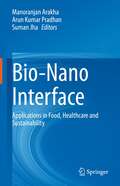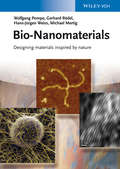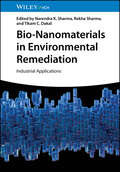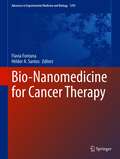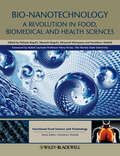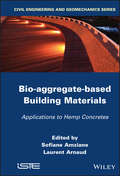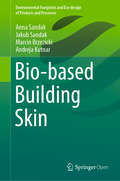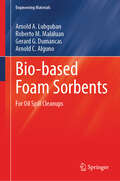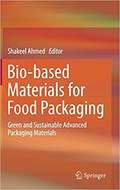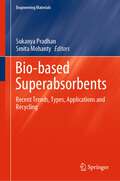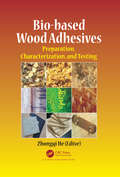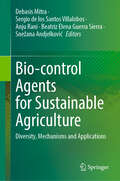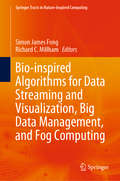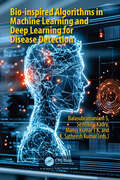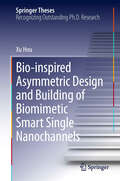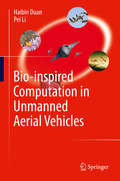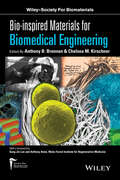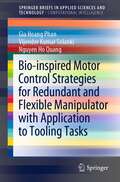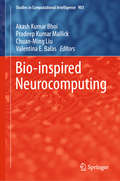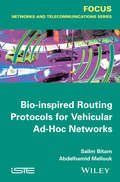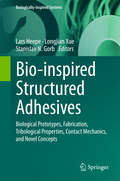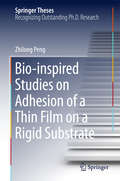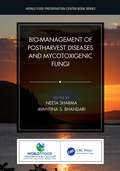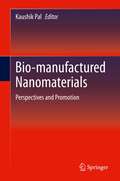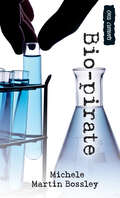- Table View
- List View
Bio-Nano Interface: Applications in Food, Healthcare and Sustainability
by Manoranjan Arakha Suman Jha Arun Kumar PradhanThis book discusses the unique interactions of nanoparticles with various biomolecules under different environmental conditions. It describes the consequences of these interactions on other biological aspects like flora and fauna of the niche, cell proliferation, etc. The book provides information about the novel and eco-friendly nanoparticle synthesis methods, such as continuous synthesis of nanoparticles using microbial cells. Additionally, the book discusses nanoparticles' potential impact in different areas of biological sciences like food, medicine, agriculture, and the environment. Due to their advanced physicochemical properties, nanoparticles have revolutionized biomedical and pharmaceutical sciences. Inside the biological milieu, nanoparticles interact with different moieties to adopt stable shape, size, and surface functionalities and form nano-biomolecular complexes. The interaction pattern at the interface form complexes determines the fate of interacting biomolecules and nanoparticles inside the biological system. Understanding the interaction pattern at the nano-bio interface is crucial for the safe use of nanoparticles in natural sciences. This book rightly addresses all questions about the interaction and the ensuing structure and function of these nano-biomolecular complexes. This book caters to students and researchers in the area of biotechnology, microbiology, and pharmaceutical sciences.
Bio-Nanomaterials
by Hans-Jürgen Weiss Wolfgang Pompe Michael Mertig Gerhard RödelBio-nanotechnology covers the development of novel techniques and materials by making use ofthe inspiration derived from biomolecular structures and processes. The progress in molecular biology and microbiology over the past 50 years has provided a solid basis for such development.Well characterized natural biomolecules as well as tailored recombinant proteins and tailored microorganisms obtained by genetic engineering provide a large "toolbox" for the implementation ofbiological structures in a technical environment. Biologically inspired materials engineering enables,for example, the preparation of living tissue for regenerative bone therapy and the biologicallycontrolled mineralization of precious metal catalysts via immobilized microorganisms.Written by authors from different fields to reflect the interdisciplinary nature of the topic, thisbook guides the reader through novel nano-materials processing inspired by nature. The presentationis structured around general principles in seven chapters, each composed of three parts:(1) biological case studies providing the motivation, (2) elucidation of the particular principle,(3) applications related to materials processing.
Bio-Nanomaterials in Environmental Remediation: Industrial Applications
by Rekha Sharma Narendra K. Sharma Tikam C. DakalReference on using bio-nanomaterials to remove pollution in industrial sectors ranging from food and agriculture to oil and gas Bio-Nanomaterials in Environmental Remediation discusses the application of bio-nanomaterials in various industrial settings. Bio-Nanomaterials in Environmental Remediation includes information on: Fundamentals, classification, and applications of bio-nanomaterials, technologies for the fabrication of bio-nanomaterials, and desalination of wastewater using bio-nanomaterials Applications of bio-nanomaterials in the textiles, oil, gas, food, and agriculture industries Hazard, toxicity, and monitoring standards of bio-nanomaterials Current challenges of bio-nanomaterials in industrial applications and future outlooks in the field Strategies to manage the safety of bio-nanomaterials to enable the creation of healthy and pollution-free environments Bio-Nanomaterials in Environmental Remediation is an essential up-to-date reference for professionals, researchers, and scientists working in fields where bio-nanomaterials are used.
Bio-Nanomedicine for Cancer Therapy (Advances in Experimental Medicine and Biology #1295)
by Flavia Fontana Hélder A. SantosThe book covers the latest developments in biologically-inspired and derived nanomedicine for cancer therapy. The purpose of the book is to illustrate the significance of naturally-mimicking systems for enhancing the dose delivered to the tumor, to improve stability, and prolong the circulation time. Moreover, readers are presented with advanced materials such as adjuvants for immunostimulation in cancer vaccines. The book also provides a comprehensive overview of the current status of academic research. This is an ideal book for students, researchers, and professors working in nanotechnology, cancer, targeted drug delivery, controlled drug release, materials science, and biomaterials as well as companies developing cancer immunotherapy.
Bio-Nanotechnology: A Revolution in Food, Biomedical and Health Sciences (Hui: Food Science and Technology #11)
by Fereidoon Shahidi Manashi Bagchi Hiroyoshi MoriyamaBio-nanotechnology is the key functional technology of the 21st century. It is a fusion of biology and nanotechnology based on the principles and chemical pathways of living organisms, and refers to the functional applications of biomolecules in nanotechnology. It encompasses the study, creation, and illumination of the connections between structural molecular biology, nutrition and nanotechnology, since the development of techniques of nanotechnology might be guided by studying the structure and function of the natural nano-molecules found in living cells. Biology offers a window into the most sophisticated collection of functional nanostructures that exists. This book is a comprehensive review of the state of the art in bio-nanotechnology with an emphasis on the diverse applications in food and nutrition sciences, biomedicine, agriculture and other fields. It describes in detail the currently available methods and contains numerous references to the primary literature, making this the perfect “field guide” for scientists who want to explore the fascinating world of bio-nanotechnology. Safety issues regarding these new technologies are examined in detail. The book is divided into nine sections – an introductory section, plus: Nanotechnology in nutrition and medicine Nanotechnology, health and food technology applications Nanotechnology and other versatile applications Nanomaterial manufacturing Applications of microscopy and magnetic resonance in nanotechnology Applications in enhancing bioavailability and controlling pathogens Safety, toxicology and regulatory aspects Future directions of bio-nanotechnology The book will be of interest to a diverse range of readers in industry, research and academia, including biologists, biochemists, food scientists, nutritionists and health professionals.
Bio-aggregate-based Building Materials: Applications to Hemp Concretes (Rilem State-of-the-art Reports #23)
by Laurent Arnaud Sofiane AmzianeUsing plant material as raw materials for construction is a relatively recent and original topic of research. This book presents an overview of the current knowledge on the material properties and environmental impact of construction materials made from plant particles, which are renewable, recyclable and easily available. It focuses on particles and as well on fibers issued from hemp plant, as well as discussing hemp concretes. The book begins by setting the environmental, economic and social context of agro-concretes, before discussing the nature of plant-based aggregates and binders. The formulation, implementation and mechanical behavior of such building materials are the subject of the following chapters. The focus is then put upon the hygrothermal behavior and acoustical properties of hempcrete, followed by the use of plant-based concretes in structures. The book concludes with the study of life-cycle analysis (LCA) of the environmental characteristics of a banked hempcrete wall on a wooden skeleton. Contents 1. Environmental, Economic and Social Context of Agro-Concretes, Vincent Nozahic and Sofiane Amziane. 2. Characterization of Plant-Based Aggregates. Vincent Picandet. 3. Binders, Gilles Escadeillas, Camille Magniont, Sofiane Amziane and Vincent Nozahic. 4. Formulation and Implementation, Christophe Lanos, Florence Collet, Gérard Lenain and Yves Hustache. 5. Mechanical Behavior, Laurent Arnaud, Sofiane Amziane, Vincent Nozahic and Etienne Gourlay. 6. Hygrothermal Behavior of Hempcrete, Laurent Arnaud, Driss Samri and Étienne Gourlay. 7. Acoustical Properties of Hemp Concretes, Philippe Glé, Emmanuel Gourdon and Laurent Arnaud. 8. Plant-Based Concretes in Structures: Structural Aspect – Addition of a Wooden Support to Absorb the Strain, Philippe Munoz and Didier Pipet. 9. Examination of the Environmental Characteristics of a Banked Hempcrete Wall on a Wooden Skeleton, by Lifecycle Analysis: Feedback on the LCA Experiment from 2005, Marie-Pierre Boutin and Cyril Flamin. About the Authors Sofiane Amziane is Professor and head of the Civil Engineering department at POLYTECH Clermont-Ferrand in France. He is also in charge of the research program dealing with bio-based building materials at Blaise Pascal University (Institut Pascal, Clermont Ferrand, France). He is the secretary of the RILEM Technical Committee 236-BBM dealing with bio-based building materials and the author or co-author of over one hundred papers in scientific journals such as Cement and Concrete Research, Composite Structures or Construction Building Materials as well as international conferences. Laurent Arnaud is a Bridges, Waters and Forestry Engineer (Ingénieur des Ponts, Eaux et Forêts) and researcher at Joseph Fourier University in Grenoble, France. He is also Professor at ENTPE (Ecole Nationale des Travaux Publics de l’Etat). Trained in the field of mechanical engineering, his research has been directed toward the characterization and development of new materials for civil engineering and construction. He is head of the international committee at RILEM – BBM, as well as the author of more than one hundred publications, and holder of an international invention patent.
Bio-based Building Skin (Environmental Footprints and Eco-design of Products and Processes)
by Andreja Kutnar Anna Sandak Jakub Sandak Marcin BrzezickiThis book provides a compendium of material properties, demonstrates several successful examples of bio-based materials’ application in building facades, and offers ideas for new designs and novel solutions. It features a state-of-the-art review, addresses the latest trends in material selection, assembling systems, and innovative functions of facades in detail. Selected case studies on buildings from diverse locations are subsequently presented to demonstrate the successful implementation of various biomaterial solutions, which defines unique architectural styles and building functions. The structures, morphologies and aesthetic impressions related to bio-based building facades are discussed from the perspective of art and innovation; essential factors influencing the performance of materials with respect to functionality and safety are also presented. Special emphasis is placed on assessing the performance of a given facade throughout the service life of a building, and after its end. The book not only provides an excellent source of technical and scientific information, but also contributes to public awareness by demonstrating the benefits to be gained from the proper use of bio-based materials in facades. As such, it will appeal to a broad audience including architects, engineers, designers and building contractors.
Bio-based Foam Sorbents: For Oil Spill Cleanups (Engineering Materials)
by Arnold A. Lubguban Roberto M. Malaluan Gerard G. Dumancas Arnold C. AlgunoThis book highlights the advantages of using sorbents in oil spill cleanup while dealing with the challenges of limited capacity and disposal. Bio-based foam sorbents are new but promising sorbents to oil spill cleanup. They are environmentally friendly materials derived from renewable resources such as vegetable oil and biomass, designed to absorb or adsorb oil and other pollutants from water, coastal areas, wetlands, ice-covered waters, and urban surfaces. These foams offer a sustainable alternative to traditional petroleum-based sorbents, with comparable or even superior performance in oil adsorption capacity, recyclability, and biodegradability. Moreover, a bio-based foam sorbent with inherent hydrophobic property is discussed, opening a new pathway for bio-based foam sorbents that usually need surface modification. This book is a good read for environmental scientists, engineers, sustainability experts, and researchers offering insights in related to the chemistry, performance, and commercialization potential of bio-based foam sorbents. It explores various methods for synthesizing bio-based foam sorbents, providing a detailed examination of the underlying chemistry involved in these processes.
Bio-based Materials for Food Packaging: Green and Sustainable Advanced Packaging Materials
by Shakeel AhmedThis book provides an overview of the lastest developments in biobased materials and their applications in food packaging. Written by experts in their respective research domain, its thirteen chapters discuss in detail fundamental knowledge on bio based materials. It is intended as a reference book for researchers, students, research scholars, academicians and scientists seeking biobased materials for food packaging applications.
Bio-based Superabsorbents: Recent Trends, Types, Applications and Recycling (Engineering Materials)
by Smita Mohanty Sukanya PradhanThis book examines the synthetic approaches, properties, applications, and recyclability of bio-based superabsorbent polymers (SAP) in depth. It describes and compares bio-based SAPs with petro-based SAPs. Additionally, it explores the structure–property relationships of bio-based SAPs derived from various natural sources. The book covers current and emerging applications in health and hygiene products, agriculture, construction, and other areas. It also explores the recycling and reusing methods available for water recovery, pressure sensitive adhesives, etc. It discusses the issues behind the sharp increase in research attention, namely the prevailing research hotspots/clusters and suggestions with regard to present studies, works that have been significant and pivotal in the development of SAP research, and the current advances and future directions of research. It also presents the emerging applications of superabsorbent polymers.
Bio-based Wood Adhesives: Preparation, Characterization, and Testing
by Zhongqi HeAdhesive bonding plays an increasing role in the forest product industry and is a key factor for efficiently utilizing timber and other lignocellulosic resources. As synthetic wood adhesives are mostly derived from depleting petrochemical resources and have caused increasing environmental concern, natural product and byproduct-derived adhesives have attracted much attention in the last decades. Although adhesives made from plant and animal sources have been in existence since ancient times, increased knowledge of their chemistry and improved technical formulation of their preparation are still needed to promote their broader industrial applications. The primary goals of this book are to (1) synthesize the fundamental knowledge and latest research on bio-based adhesives from a remarkable range of natural products and byproducts, (2) identify need areas and provide directions of future bio-based adhesive research, and (3) help integrating research findings in practical adhesive application for maximal benefits. This book covers information on a variety of natural products and byproducts and the latest research on formulation, testing and improvement of the relevant adhesives in fifteen chapters written by an international group of accomplished contributors. This book will serve as a valuable reference source for university faculty, graduate students, research scientists, agricultural and wood engineers, international organization advocators and government agency regulators who work and deal with enhanced utilization of agricultural and forest products and byproducts.
Bio-control Agents for Sustainable Agriculture: Diversity, Mechanisms and Applications
by Debasis Mitra Sergio de los Santos Villalobos Anju Rani Beatriz Elena Guerra Sierra Snežana AndjelkovićThis book covers all aspects of the diversity and core microbiome of the bio-control agents. Their bioprospecting and application at the field level is also discussed. The application of bio-control agents is unique in plant production due to various reasons, including its environment-friendly nature, management of plant resistance and incentivizing the rhizosphere to phyllosphere signaling. The chapters provide information on major plant-associated diversity of beneficial microorganisms, various pathogen management strategies, and improving plant immunity by the application of bio-control agents. Additionally, the exploitation, development, and quality control of bio-control agent-based formulations for farming systems and industrial-level production is discussed. This approach provides a novel framework for fostering sustainable development in crop production and protection. The book targets researchers, microbiology students, the biofertilizers industry, and those in agricultural and environmental fields.
Bio-inspired Algorithms for Data Streaming and Visualization, Big Data Management, and Fog Computing (Springer Tracts in Nature-Inspired Computing)
by Simon James Fong Richard C. MillhamThis book aims to provide some insights into recently developed bio-inspired algorithms within recent emerging trends of fog computing, sentiment analysis, and data streaming as well as to provide a more comprehensive approach to the big data management from pre-processing to analytics to visualization phases. The subject area of this book is within the realm of computer science, notably algorithms (meta-heuristic and, more particularly, bio-inspired algorithms). Although application domains of these new algorithms may be mentioned, the scope of this book is not on the application of algorithms to specific or general domains but to provide an update on recent research trends for bio-inspired algorithms within a specific application domain or emerging area. These areas include data streaming, fog computing, and phases of big data management. One of the reasons for writing this book is that the bio-inspired approach does not receive much attention but shows considerable promise and diversity in terms of approach of many issues in big data and streaming. Some novel approaches of this book are the use of these algorithms to all phases of data management (not just a particular phase such as data mining or business intelligence as many books focus on); effective demonstration of the effectiveness of a selected algorithm within a chapter against comparative algorithms using the experimental method. Another novel approach is a brief overview and evaluation of traditional algorithms, both sequential and parallel, for use in data mining, in order to provide an overview of existing algorithms in use. This overview complements a further chapter on bio-inspired algorithms for data mining to enable readers to make a more suitable choice of algorithm for data mining within a particular context. In all chapters, references for further reading are provided, and in selected chapters, the author also include ideas for future research.
Bio-inspired Algorithms in Machine Learning and Deep Learning for Disease Detection
by Seifedine Kadry S Balasubramaniam T K Manoj Kumar K. Satheesh KumarCurrently, computational intelligence approaches are utilised in various science and engineering applications to analyse information, make decisions, and achieve optimisation goals. Over the past few decades, various techniques and algorithms have been created in disciplines such as genetic algorithms, artificial neural networks, evolutionary algorithms, and fuzzy algorithms. In the coming years, intelligent optimisation algorithms are anticipated to become more efficient in addressing various issues in engineering, scientific, medical, space, and artificial satellite fields, particularly in early disease diagnosis. A metaheuristic in computer science is designed to discover optimisation algorithms capable of solving intricate issues. Metaheuristics are optimisation algorithms that mimic biological behaviours of animals or birds and are utilised to discover the best solution for a certain problem. A meta-heuristic is an advanced approach used by heuristics to tackle intricate optimisation problems. A metaheuristic in mathematical programming is a method that seeks a solution to an optimisation problem. Metaheuristics utilise a heuristic function to assist in the search process. Heuristic search can be categorised as blind search or informed search. Meta-heuristic optimisation algorithms are gaining popularity in various applications due to their simplicity, independence from data trends, ability to find optimal solutions, and versatility across different fields. Recently, many nature-inspired computation algorithms have been utilised to diagnose people with different diseases. Nature-inspired methodologies are now widely utilised across several fields for tasks such as data analysis, decision-making, and optimisation. Techniques inspired by nature are categorised as either biology-based or natural phenomena-based. Bioinspired computing encompasses various topics in computer science, mathematics, and biology in recent years. Bio-inspired computer optimisation algorithms are a developing method that utilises concepts and inspiration from biological development to create new and resilient competitive strategies. Bio-inspired optimisation algorithms have gained recognition in machine learning and deep learning for solving complicated issues in science and engineering. Utilising BIAs learning methods with machine learning and deep learning shows great promise for accurately classifying medical conditions. This book explores the historical development of bio-inspired algorithms and their application in machine learning and deep learning models for disease diagnosis, including COVID-19, heart diseases, cancer, diabetes and some other diseases. It discusses the advantages of using bio-inspired algorithms in disease diagnosis and concludes with research directions and future prospects in this field.
Bio-inspired Asymmetric Design and Building of Biomimetic Smart Single Nanochannels (Springer Theses)
by Xu HouIn this thesis, the author introduces various bio-inspired smart nanochannel systems. A strategy for design and preparation of novel artificial responsive symmetric/asymmetric single nanochannel systems under various symmetric/asymmetric stimuli is presented for the first time. The author's research work utilizes ion track etching polymer nanochannels with different shapes as examples to demonstrate the feasibility of the design strategy for building novel artificial functional nanochannels using various symmetric/asymmetric physicochemical modifications. The development of these nanochannels and their potential applications is a burgeoning new area of research, and a number of exciting breakthroughs may be anticipated in the near future from the concepts and results reported in this thesis. Research into artificial functional nanochannels continues to drive new developments of various real-world applications, such as biosensors, energy conversion systems and nanofluidic devices. The work in this thesis has led to more than 15 publications in high-profile journals.
Bio-inspired Computation in Unmanned Aerial Vehicles
by Haibin Duan Pei LiBio-inspired Computation in Unmanned Aerial Vehicles focuses on the aspects of path planning, formation control, heterogeneous cooperative control and vision-based surveillance and navigation in Unmanned Aerial Vehicles (UAVs) from the perspective of bio-inspired computation. It helps readers to gain a comprehensive understanding of control-related problems in UAVs, presenting the latest advances in bio-inspired computation. By combining bio-inspired computation and UAV control problems, key questions are explored in depth, and each piece is content-rich while remaining accessible. With abundant illustrations of simulation work, this book links theory, algorithms and implementation procedures, demonstrating the simulation results with graphics that are intuitive without sacrificing academic rigor. Further, it pays due attention to both the conceptual framework and the implementation procedures. The book offers a valuable resource for scientists, researchers and graduate students in the field of Control, Aerospace Technology and Astronautics, especially those interested in artificial intelligence and Unmanned Aerial Vehicles. Professor Haibin Duan and Dr. Pei Li, both work at Beihang University (formerly Beijing University of Aeronautics & Astronautics, BUAA). Prof Duan's academic website is: http://hbduan. buaa. edu. cn
Bio-inspired Materials for Biomedical Engineering
by Chelsea M. Kirschner Anthony B. BrennanThis book covers the latest bio-inspired materials synthesis techniques and biomedical applications that are advancing the field of tissue engineering. Bio-inspired concepts for biomedical engineering are at the forefront of tissue engineering and regenerative medicine. Scientists, engineers and physicians are working together to replicate the sophisticated hierarchical organization and adaptability found in nature and selected by evolution to recapitulate the cellular microenvironment. This book demonstrates the dramatic clinical breakthroughs that have been made in engineering all four of the major tissue types and modulating the immune system.Part I (Engineering Bio-inspired Material Microenvironments) covers Bio-inspired Presentation of Chemical Cues, Bio-inspired Presentation of Physical Cues, and Bio-inspired Integration of Natural Materials. Part II (Bio-inspired Tissue Engineering) addresses tissue engineering in epithelial tissue, muscle tissue, connective tissue, and the immune system.
Bio-inspired Motor Control Strategies for Redundant and Flexible Manipulator with Application to Tooling Tasks (SpringerBriefs in Applied Sciences and Technology)
by Vijender Kumar Solanki Nguyen Ho Quang Gia Hoang PhanThis book presents a multi-disciplinary view of all aspects of rehabilitation robotics and non-invasive surgery, ideal for anyone new to the field. It includes perspectives from both engineers and clinicians. For skilled researchers and clinicians, it also summarizes current robot technologies and their application to various pathologies. The book will help the readers to develop the know-how and expertise necessary to guide those seeking a comprehensive understanding of this topic through their use of several commercial devices for robotic rehabilitation. The book targets the implementation of efficient robot strategies to facilitate the re-acquisition of motor skills. This technology incorporates the outcomes of behavioral studies on motor learning and its neural correlates into the design, implementation, and validation of robot agents that behave as optimal trainers, efficiently exploiting the structure and plasticity of the human sensorimotor systems.
Bio-inspired Neurocomputing (Studies in Computational Intelligence #903)
by Akash Kumar Bhoi Valentina E. Balas Pradeep Kumar Mallick Chuan-Ming LiuThis book covers the latest technological advances in neuro-computational intelligence in biological processes where the primary focus is on biologically inspired neuro-computational techniques. The theoretical and practical aspects of biomedical neural computing, brain-inspired computing, bio-computational models, artificial intelligence (AI) and machine learning (ML) approaches in biomedical data analytics are covered along with their qualitative and quantitative features. The contents cover numerous computational applications, methodologies and emerging challenges in the field of bio-soft computing and bio-signal processing. The authors have taken meticulous care in describing the fundamental concepts, identifying the research gap and highlighting the problems with the strategical computational approaches to address the ongoing challenges in bio-inspired models and algorithms. Given the range of topics covered, this book can be a valuable resource for students, researchers as well as practitioners interested in the rapidly evolving field of neurocomputing and biomedical data analytics.
Bio-inspired Routing Protocols for Vehicular Ad-Hoc Networks
by Abdelhamid Mellouk Salim BitamVehicular Ad-Hoc Networks (VANETs) play a key role to develop Intelligent Transportation Systems (ITS) aiming to achieve road safety and to guaranty needs of drivers and passengers, in addition to improve the transportation productivity. One of the most important challenges of this kind of networks is the data routing between VANET nodes which should be routed with high level of Quality of Service (QoS) to ensure receiving messages in the time. Then, the driver can take the appropriate decision to improve the road safety. In the literature, there are several routing protocols for VANETs which are more or less reliable to reach safety requirements. In this book, we start by describing all VANET basic concepts such as VANET definition, VANET versus Mobile ad-Hoc Network (MANET), architectures, routing definition and steps, Quality of Service (QoS) for VANET Routing, Metrics of evaluation, Experimentation, and simulation of VANETs, mobility patterns of VANET etc. Moreover, different routing protocols for routing in VANETs will be described. We propose two main categories to be presented: classical routing and bio-inspired routing. Concerning classical VANET, main principles and all phases will be overviewed, as well as, their two sub-categories which are topological and geographical protocols. After that, we propose a new category called bio-inspired routing which is inspired by natural phenomenon such as Ant colony, Bee life, Genetic operators etc. We present also, some referential protocols as example of each category. In this book, we focus on the idea of how to apply bio-inspired principle into VANET routing to improve road safety, and to ensure QoS of vehicular applications.
Bio-inspired Structured Adhesives: Biological Prototypes, Fabrication, Tribological Properties, Contact Mechanics, and Novel Concepts (Biologically-Inspired Systems #9)
by Stanislav N. Gorb Lars Heepe Longjian XueThis book deals with the adhesion, friction and contact mechanics of living organisms. Further, it presents the remarkable adhesive abilities of the living organisms which inspired the design of novel micro- and nanostructured adhesives that can be used in various applications, such as climbing robots, reusable tapes, and biomedical bandages. The technologies for both the synthesis and construction of bio-inspired adhesive micro- and nanostructures, as well as their performance, are discussed in detail. Representatives of several animal groups, such as insects, spiders, tree frogs, and lizards, are able to walk on (and therefore attach to) tilted, vertical surfaces, and even ceilings in different environments. Studies have demonstrated that their highly specialized micro- and nanostructures, in combination with particular surface chemistries, are responsible for this impressive and reversible adhesion. These structures can maximize the formation of large effective contact areas on surfaces of varying roughness and chemical composition under different environmental conditions.
Bio-inspired Studies on Adhesion of a Thin Film on a Rigid Substrate (Springer Theses)
by Zhilong PengThe thesis systematically investigates the factors which influence many animals' robust adhesion abilities and micro-reversible adhesion mechanisms, including the geometric principles of their adhesion, relative humidity, surface roughness and pre-tension. Studies exploring biological adhesion mechanisms are not only of great significance for the design of advanced adhesive materials and adhesion systems for micro-climbing robots, but also very helpful for resolving the problem of adhesion failure in MEMS/NEMS.
Bio-management of Postharvest Diseases and Mycotoxigenic Fungi (World Food Preservation Center Book Series)
by Neeta Sharma and Avantina S. BhandariThere is an ever-increasing demand for more food but one of the stumbling blocks to achieving this goal is quality and quantity losses due to various pests and pathogens and the mycotoxins synthesized by these harmful biotic entities. Thus far, strategies employed to manage these post-harvest diseases and mycotoxins decontamination include established physical, cultural, and chemical methods. Recently, the application of chemicals to reduce decay and deterioration caused by various pathogens has been impeded as these hazardous chemicals contaminate the environment, enter the food chain, and destroy beneficial microorganisms and pests by aiming at non-target microorganisms. In light of this, the usage of eco-friendly and non-polluting alternatives to chemical pesticides is the call of the hour. Bio-management of Postharvest Diseases and Mycotoxigenic Fungi deals with the current state and future prospects of using various bio-management techniques that are natural, eco-friendly, and environmentally safe. It aims to increase awareness of their potential as well as sensitizing readers to the various aspects of biologicals in pest control. Key Features: Highlights classical versus new techniques adopted to manage postharvest diseases Discusses novel approaches in managing fungal spoilage and mycotoxin decontamination Provides readers with a 360-degree perspective of the pre- and post-harvest quality mycotoxin decontamination research being conducted Details proposals of new ideas to ensure a food secure and pesticide-free world This book disseminates notable and diversified scientific work carried out by leading experts in their own field. Written by qualified scientists in each of their respective disciplines, it can serve as a current and comprehensive treatise on the emerging field of bio-management of postharvest diseases and mycotoxin decontamination by products that are "generally regarded as safe."
Bio-manufactured Nanomaterials: Perspectives and Promotion
by Kaushik PalThis book is based on the principles, limitations, challenges, improvements and applications of nanotechnology in medical science as described in the literature. It highlights various parameters affecting the synthesis of bio-nanomaterials and exclusive techniques utilized for characterizing the nanostructures for their potential use in biomedical and environmental applications. Moreover, biodegradable synthesis of nanomaterials is regarded as an important tool to reduce the destructive effects associated with the traditional methods of synthesis for nanostructures commonly utilized in laboratory and industry and as well as academic scale of innovative research foundation.
Bio-pirate (Orca Currents)
by Michele Martin BossleyTrevor, Robyn and Nick decide they have a mystery to solve when Trevor discovers a suspicious looking young man snooping around. They learn about missing research involving the use of carob beans to aid in cancer treatment-potentially valuable information. With a shady looking grad student, a bitter activist and an employee of a medical research firm to deal with, our amateur sleuths are faced with their greatest challenge yet.
